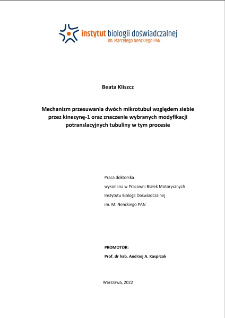- Wyszukaj w całym Repozytorium
- Piśmiennictwo i mapy
- Archeologia
- Baza Młynów
- Nauki przyrodnicze
Wyszukiwanie zaawansowane
Wyszukiwanie zaawansowane
Wyszukiwanie zaawansowane
Wyszukiwanie zaawansowane
Wyszukiwanie zaawansowane

Obiekt
Tytuł: Mechanizm przesuwania dwóch mikrotubul względem siebie przez kinezynę-1 oraz znaczenie wybranych modyfikacji potranslacyjnych tubuliny w tym procesie : praca doktorska
Twórca instytucjonalny:
Instytut Biologii Doświadczalnej im. Marcelego Nenckiego PAN.
Współtwórca:
Kasprzak, Andrzej : Supervisor
Wydawca:
Instytut Biologii Doświadczalnej im. M. Nenckiego PAN
Miejsce wydania:
Opis:
205 pages : illustrations ; 30 cm + 1 CD ; Bibliography ; Summary in English
Uzyskany tytuł:
Dyscyplina :
Instytucja nadająca tytuł:
Nencki Institute of Experimental Biology PAS ; degree obtained: 12.10.2022
Typ obiektu:
Abstrakt:
Kinesin-1 is a motor protein that converts energy from ATP hydrolysis into mechanical movement. This motor protein "walks" on the microtubule (MT) towards its plus end. Kinesin-1 is a heterotetramer composed of two heavy chains and two light chains. The heavy chain consists of a motor domain (amino terminus) containing a catalytic center, a neck linker, a coiled-coil domain and, at the carboxy terminus, a tail which is responsible for cargo binding. The main role of kinesin-1 in cells is to transport various cargoes from the cell body to its distal parts and to reorganize the microtubular cytoskeleton.The two kinesin-1 heavy chains contain two MT binding sites - one in the motor domain, and the other in the tail. As a result, kinesin-1 can simultaneously interact with two MTs, and cross-link them or move them against each other. In the neuron, this process is necessary during axon formation - mechanical pressure on the cell membrane initiates and directs the formation of a neurite. However, still little is known about the mechanism of MT sliding by kinesin-1, the mutual orientation of the MTs during movement, the way kinesin molecules bind between the MTs, and the regulation of these processes.In order to investigate the mechanism of MT-pair sliding driven by kinesin-1, a new in vitro motility assay was developed. Full length recombinant dimeric kinesin-1 without light chains was tested. Both kinesin-1 and MTs were marked with fluorescent dyes which enabled their individual observation and visualization using a total internal reflection microscopy (TIRFM). This technique allowed the simultaneous observation of the kinesin-1 as well as the cargo MT and stationary MT, which contained different proportions of the fluorescent dye in order to distinguish them from each other.Analysis of the movies obtained from TIRFM showed that the average velocity of MT-MT sliding by kinesin-1 (120 nm/s) is much lower than for kinesin-1 single molecules (600 nm/s) or in gliding assay (1200 nm/s). Contrary to the other two analyzes, MT-MT sliding was not smooth, there were visible breaks in movement, and there were often significant interruptions during MT transport. Experiments with polarity marked MTs showed that there were 3 ways of MT-MT sliding and stationary MT orientation: sliding of the anti-parallel MTs to the plus end, parallel MT sliding towards the minus end, and parallel sliding to the plus end of the stationary MT. Unexpectedly, it turned out that not only anti-parallel MTs are transported, as observed for other motor proteins, but also parallel MTs, which, according to the mechanism suggested in this thesis, is the result of the processive generation of movement by kinesin-1.Kinesin-1 can undergo autoinhibition – a change in conformation that prevents movement, which could make it difficult to repeatedly observe the process of MT sliding. To eliminate the flexible kinesin fragment necessary for autoinhibition (molecular hinge- 2, Δ505-610), a construct lacking hinge-2 was created using molecular biology tools. It turned out that hingeless kinesin-1 performed MT-pair sliding 6 times less frequently, with run length 5 times lower comparing to wild-type kinesin-1. Thus, the presence of an elastic fragment is necessary to compensate the lack of synchronization among the kinesin-1 molecules transporting the same MT.The effect of post-translational modifications of tubulin on MT-MT sliding by kinesin-1 was also investigated. It has been shown that for detyrosinated microtubules, the duration of the movement is longer than for the tyrosinated ones. Concerning glutamylation of microtubules, a lower percentage of movement interruptions was observed as compared to the control. On the other hand, the analysis of the velocity and run length of transport showed no significant effects of the post-translational modifications of tubulin investigated here
Szczegółowy typ zasobu:
Identyfikator zasobu:
Źródło:
Język:
Język streszczenia:
Prawa:
Zasady wykorzystania:
Copyright-protected material. May be used within the limits of statutory user freedoms
Właściciel praw autorskich:
Publication made available with the written permission of the author
Digitalizacja:
Nencki Institute of Experimental Biology of the Polish Academy of Sciences
Lokalizacja oryginału:
Library of the Nencki Institute of Experimental Biology PAS
Dostęp:
Kolekcje, do których przypisany jest obiekt:
- Repozytorium Cyfrowe Instytutów Naukowych > Kolekcje Partnerów > Instytut Biologii Doświadczalnej PAN > Prace dyplomowe
- Repozytorium Cyfrowe Instytutów Naukowych > Kolekcje Partnerów > Instytut Biologii Doświadczalnej PAN > Prace dyplomowe > Prace doktorskie
- Repozytorium Cyfrowe Instytutów Naukowych > Piśmiennictwo > Prace dyplomowe
Data ostatniej modyfikacji:
16 gru 2024
Data dodania obiektu:
10 paź 2022
Liczba pobrań / odtworzeń:
298
Wszystkie dostępne wersje tego obiektu:
https://rcin.org.pl./publication/272889
Wyświetl opis w formacie RDF:
Wyświetl opis w formacie RDFa:
Wyświetl opis w formacie OAI-PMH:
| Nazwa wydania | Data |
|---|---|
| Kliszcz, Beata | 16 gru 2024 |

 INSTYTUT ARCHEOLOGII I ETNOLOGII POLSKIEJ AKADEMII NAUK
INSTYTUT ARCHEOLOGII I ETNOLOGII POLSKIEJ AKADEMII NAUK
 INSTYTUT BADAŃ LITERACKICH POLSKIEJ AKADEMII NAUK
INSTYTUT BADAŃ LITERACKICH POLSKIEJ AKADEMII NAUK
 INSTYTUT BADAWCZY LEŚNICTWA
INSTYTUT BADAWCZY LEŚNICTWA
 INSTYTUT BIOLOGII DOŚWIADCZALNEJ IM. MARCELEGO NENCKIEGO POLSKIEJ AKADEMII NAUK
INSTYTUT BIOLOGII DOŚWIADCZALNEJ IM. MARCELEGO NENCKIEGO POLSKIEJ AKADEMII NAUK
 INSTYTUT BIOLOGII SSAKÓW POLSKIEJ AKADEMII NAUK
INSTYTUT BIOLOGII SSAKÓW POLSKIEJ AKADEMII NAUK
 INSTYTUT CHEMII FIZYCZNEJ PAN
INSTYTUT CHEMII FIZYCZNEJ PAN
 INSTYTUT CHEMII ORGANICZNEJ PAN
INSTYTUT CHEMII ORGANICZNEJ PAN
 INSTYTUT FILOZOFII I SOCJOLOGII PAN
INSTYTUT FILOZOFII I SOCJOLOGII PAN
 INSTYTUT GEOGRAFII I PRZESTRZENNEGO ZAGOSPODAROWANIA PAN
INSTYTUT GEOGRAFII I PRZESTRZENNEGO ZAGOSPODAROWANIA PAN
 INSTYTUT HISTORII im. TADEUSZA MANTEUFFLA POLSKIEJ AKADEMII NAUK
INSTYTUT HISTORII im. TADEUSZA MANTEUFFLA POLSKIEJ AKADEMII NAUK
 INSTYTUT JĘZYKA POLSKIEGO POLSKIEJ AKADEMII NAUK
INSTYTUT JĘZYKA POLSKIEGO POLSKIEJ AKADEMII NAUK
 INSTYTUT MATEMATYCZNY PAN
INSTYTUT MATEMATYCZNY PAN
 INSTYTUT MEDYCYNY DOŚWIADCZALNEJ I KLINICZNEJ IM.MIROSŁAWA MOSSAKOWSKIEGO POLSKIEJ AKADEMII NAUK
INSTYTUT MEDYCYNY DOŚWIADCZALNEJ I KLINICZNEJ IM.MIROSŁAWA MOSSAKOWSKIEGO POLSKIEJ AKADEMII NAUK
 INSTYTUT PODSTAWOWYCH PROBLEMÓW TECHNIKI PAN
INSTYTUT PODSTAWOWYCH PROBLEMÓW TECHNIKI PAN
 INSTYTUT SLAWISTYKI PAN
INSTYTUT SLAWISTYKI PAN
 SIEĆ BADAWCZA ŁUKASIEWICZ - INSTYTUT TECHNOLOGII MATERIAŁÓW ELEKTRONICZNYCH
SIEĆ BADAWCZA ŁUKASIEWICZ - INSTYTUT TECHNOLOGII MATERIAŁÓW ELEKTRONICZNYCH
 MUZEUM I INSTYTUT ZOOLOGII POLSKIEJ AKADEMII NAUK
MUZEUM I INSTYTUT ZOOLOGII POLSKIEJ AKADEMII NAUK
 INSTYTUT BADAŃ SYSTEMOWYCH PAN
INSTYTUT BADAŃ SYSTEMOWYCH PAN
 INSTYTUT BOTANIKI IM. WŁADYSŁAWA SZAFERA POLSKIEJ AKADEMII NAUK
INSTYTUT BOTANIKI IM. WŁADYSŁAWA SZAFERA POLSKIEJ AKADEMII NAUK




































